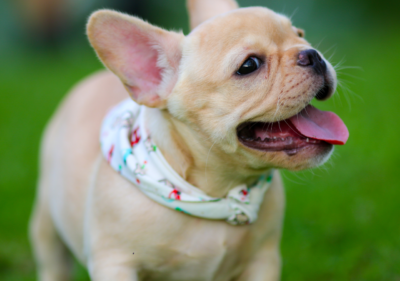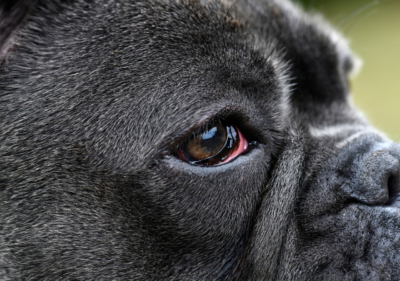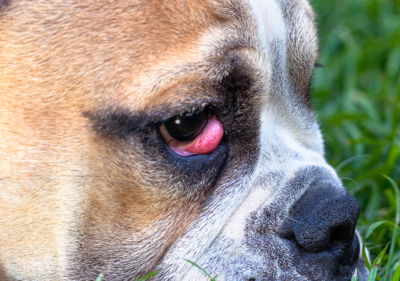Cherry Eye in French Bulldogs: What Is It and How To Treat It?

Cherry eye in French Bulldogs is a common condition that pet owners should be aware of. If you’ve just spot a red, bubbly ball in the corner of your Frenchie’s eye, then he probably started to suffer from cherry eye. Even though it looks scary at first glance, cherry eye can be successfully treated. On the other hand, lack of treatment can lead to severe complications and even loss of vision.
What is Cherry Eye in French Bulldogs?
Cherry eye in French Bulldogs is like a red alarm bell popping out in the corner of their eye. It’s actually a prolapsed gland of the third eyelid, and while it sounds a bit gross, it’s a common sight in our flat-faced furry friends. Normally, this gland stays hidden, doing its job to keep the eye moist.
But sometimes, it slips out of place and makes a grand, unwelcome appearance. It’s not as scary as it looks, but it does need a vet’s attention to tuck everything back in place and keep those puppy eyes as charming as ever.
Causes of Cherry Eye in French Bulldogs
The exact cause of cherry eye is largely unknown, but genetic factors play a significant role, especially in brachycephalic breeds like French Bulldogs. Physical traits such as shallow eye sockets and loose connective tissue around the eye can also contribute to the development of this condition. Thanks to their big, protruding eyes, Frenchies, as well as English bulldogs are prone to cherry eye.
Cherry eye itself is not typically life-threatening, but it is a condition that requires attention to prevent secondary complications that can seriously affect a dog’s health and quality of life. While this isn’t immediately life-threatening, if left untreated, cherry eye can lead to chronic eye irritation, recurring infections, and potentially severe dry eye (keratoconjunctivitis sicca). These complications can result in more serious conditions that might significantly impact the dog’s well-being and require more intensive treatment.
Symptoms of Cherry Eye in French Bulldogs
Cherry eye in French Bulldogs can be quite noticeable due to its distinctive appearance and associated symptoms. Here are some common symptoms to watch for if you suspect your French Bulldog might be developing cherry eye:
- Visible Gland Protrusion: The most obvious symptom is the appearance of a red, fleshy mass protruding from the corner of the dog’s eye. It typically appears in the lower inner corner and can look like a small cherry, hence the name.
- Eye Redness and Swelling: Besides the prolapsed gland, you may notice redness and swelling in the surrounding eye area due to irritation.
- Discharge: The affected eye may produce a clear or mucus-like discharge. If an infection develops, the discharge could become pus-like or yellowish.
- Eye Rubbing or Scratching: French Bulldogs with cherry eye may paw at their eye or rub it against surfaces like the carpet or furniture due to discomfort or itchiness.
- Squinting: Affected dogs may squint or frequently blink due to irritation or discomfort caused by the exposed gland.
- Impaired Vision: While not immediate, prolonged exposure and irritation can lead to vision impairment if not treated. This symptom is less common and usually occurs in more severe cases.
- Behavioral Changes: Dogs with uncomfortable eye conditions like cherry eye may become more withdrawn or irritable due to discomfort or pain.
Diagnosis of Cherry Eye
Veterinarians typically diagnose cherry eye based on a physical examination. In some cases, additional tests may be performed to rule out other eye conditions or complications.
How Do You Treat a Cherry Eye in a French Bulldog?
Treating cherry eye in French Bulldogs typically involves a combination of surgical intervention and supportive care. Here’s a step-by-step approach to how this condition is commonly treated:
Surgical Correction:
The most effective treatment for cherry eye is surgery. The goal of the surgery is to reposition the prolapsed gland back into its normal location. There are several surgical techniques used:
- Pocket Technique: The most common surgical method involves creating a pocket in the conjunctiva (the membrane lining the eyelid) where the gland can be tucked back into place. This method aims to secure the gland without removing it, preserving its function.
- Anchoring Technique: In some cases, the gland may be anchored to deeper structures in the eye socket to hold it in place.
- Gland Removal: Previously, removal of the prolapsed gland was practiced, but this is less common now due to the high risk of subsequent dry eye syndrome, as the gland contributes significantly to the eye’s tear production.
Post-Surgical Care: After surgery, your French Bulldog will typically need:
- Eye Drops or Ointment: These are prescribed to help reduce inflammation and prevent infection. Antibiotics and steroids are commonly used.
- Cone or Protective Collar: To prevent your dog from rubbing its eye and disrupting the healing process, a cone or protective collar is usually necessary.
- Follow-Up Visits: Regular check-ups with the veterinarian are important to ensure the eye is healing properly and to adjust treatment if needed.
Non-Surgical Management:
In very mild cases or when surgery is not an option, non-surgical management may be attempted, although it’s less commonly effective. This can include:
- Manual Repositioning: Occasionally, a vet may try to manually reposition the gland under sedation. This is typically a temporary solution, as the gland often prolapses again.
- Medication: Anti-inflammatory and lubricating eye drops can be used to manage symptoms, though they do not correct the underlying problem.
Prompt treatment is crucial to prevent complications such as chronic irritation, infection, or the development of dry eye. If you suspect your French Bulldog has cherry eye, consult your veterinarian for an accurate diagnosis and appropriate treatment plan tailored to your pet’s specific needs.
Prevention of Cherry Eye
Preventing cherry eye, particularly in breeds prone to this condition like French Bulldogs, can be challenging because the underlying causes are often genetic. However, there are several steps you can take to minimize the risks and manage the condition effectively if it does occur:
Regular Veterinary Check-ups:
Regular visits to the vet for comprehensive eye examinations can help catch early signs of cherry eye or other eye problems before they become severe. Early detection is crucial for effective management.
Proper Breeding Conventions:
Since cherry eye can have a genetic component, choosing puppies from breeders who use responsible breeding practices can help reduce the incidence of such hereditary conditions. Breeders should perform health screenings and select against traits that predispose dogs to cherry eye.
Maintain Good Eye Hygiene:
Keeping your dog’s eyes clean can help prevent irritation that might exacerbate the condition. Use a soft, damp cloth to gently wipe around your dog’s eyes and keep the fur trimmed to avoid it poking or rubbing the eye area.
Nutritional Support:
Providing a balanced diet foe your Frenchie rich in vitamins and minerals can support overall health, including eye health. Supplements like omega-3 fatty acids may help maintain healthy tissues, but you should always consult your veterinarian before starting any new supplement.
Avoid Trauma:
Since physical trauma to the head or eye area can sometimes trigger cherry eye, it’s essential to keep your dog safe from rough play and environments where injuries could occur.
Manage Allergies and Infections:
Allergies, infections, or anything that causes eye inflammation or excessive eye rubbing can potentially lead to problems like cherry eye. Addressing these issues promptly with veterinary guidance can reduce the risk.
Stress Reduction:
Reducing stress in your dog’s environment can also play a role in overall health, including eye health. Stress can weaken the immune system and contribute to health issues.
How much does cherry eye surgery cost for a French bulldog?
The cost of cherry eye surgery for a French Bulldog can vary significantly based on several factors, including geographic location, the severity of the condition, the specific veterinary clinic or hospital, and whether additional treatments are needed alongside the surgery. Generally, the price range for cherry eye surgery can be anywhere from $300 to $1,000 per eye.
Some of the factors that can affect the cost include:
Veterinarian Experience and Specialization: Specialists or highly experienced veterinarians may charge more for their services.
Type of Surgery: The surgical technique used can affect the cost. Some methods may be more complex and therefore more expensive.
Anesthesia and Medications: The cost of anesthesia and any post-surgical medications can also contribute to the overall price.
Pre- and Post-Operative Care: Costs may include pre-surgical exams and follow-up visits to ensure proper healing and recovery.
Geographic Location: Veterinary costs vary widely depending on where you live. Metropolitan areas tend to have higher fees than rural areas.
It’s a good idea to get a detailed estimate from your veterinarian after they have assessed your dog’s specific condition. This estimate should include all potential costs related to the surgery to help you budget accordingly. Additionally, pet insurance may cover a portion of the surgery if you have a policy in place, so it’s worth checking with your provider.
Dealing with Frenchie Cherry Eye: Wrapping up
We all agree that spotting an ugly-looking cherry eye on your little gremlin might seem devastating. However, with the right care and quick treatment, you can help your pet live a normal life. Therefore, take care of your dog as you would take care of yourself. In the end, our dogs are our family members.









 French Bulldog Jackets & Coats
French Bulldog Jackets & Coats French Bulldog Dresses & Skirts
French Bulldog Dresses & Skirts French Bulldog Hoodies
French Bulldog Hoodies French Bulldog Sweaters
French Bulldog Sweaters French Bulldog Shirts
French Bulldog Shirts French Bulldog Pajamas
French Bulldog Pajamas French Bulldog Costumes
French Bulldog Costumes French Bulldog Life Jackets
French Bulldog Life Jackets

 French Bulldog Collars
French Bulldog Collars French Bulldog Harness
French Bulldog Harness
 French Bulldog Backpacks
French Bulldog Backpacks








One thought on “Cherry Eye in French Bulldogs: What Is It and How To Treat It?”